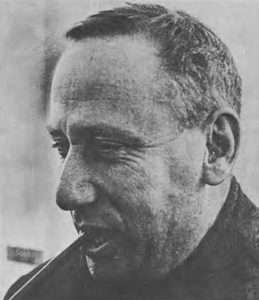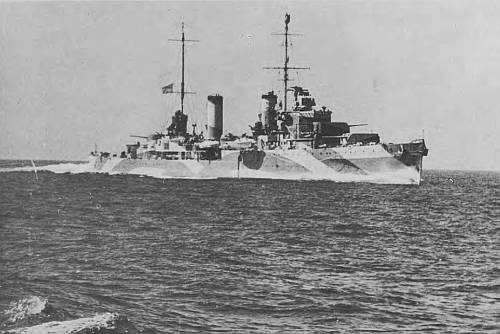- Author
- Owen, Commander P.O.L.
- Subjects
- Biographies and personal histories
- Tags
-
- RAN Ships
- None noted.
- Publication
- August 1972 edition of the Naval Historical Review (all rights reserved)

in | 941.
I returned to Australia in mid December 1941 for a month’s leave and reappointment. I was appointed Base Supply Officer (RAN) Singapore, the plan envisaged the eventual concentration there of some 50 small ships – mainly corvettes built or building in Australia. This was cancelled within a week and I was appointed to Platypus at Darwin. I disliked this thought and asked for a sea appointment. I was offered Hobart as Supply Officer and directed to await her arrival at Fremantle. I was cooling my heels in Perth, WA when HMAS Perth arrived at Fremantle. Waller gave me lunch on board and said he was having minor trouble – I think a gun mounting or turret fault. He doubted I would see Hobart arrive at Fremantle and sought and received Naval Board approval to embark myself, two other officers and three sailors for Hobart.
We sailed at midnight on Friday 13th February 1942 and on a northward escort passage I spent some hours with him yarning in his sea cabin. Things were different from the Mediterranean days where, despite the shortages of men, ships and material, the operations were British almost entirely. Certainly the Command was; whereas in this sphere, the ABDA Command was being constantly changed with resulting confusion. The news was of course as despondent as it could possibly be; and we all felt we were moving towards the trap. Waller reminisced over Mediterranean days, ‘Polo, you’ve had your fill of bombing but, believe me, gunfire is really hell let loose and far more frightening!’
A week later, I was to see what he meant when Perth was being straddled by 8 inch enemy shells! On 21st February we intercepted a signal from C-in-C Far Eastern Fleet to Admiralty (R) ACNB stating the Java situation was critical and requesting the immediate despatch to the area of all available warships. Within a few hours we received a signal from Commodore, China Force to proceed with despatch to Tandjong Priok, where we arrived late in the afternoon of 24th February. We learned of Hobart’s ETA 0800/25 February and Walter suggested I should remain on board Perth that evening and join my ship the following forenoon, instead of spending the night at a prearranged hotel accommodation at Batavia.
The next morning I arranged for the motor boat to take me and the four sailors of the draft to Hobart at 0830. Waller had already left the ship to report to Commodore China Force at Batavia for briefing and orders. Perth was alongside the wharf. We were in the boat ready to shove off when the OOW told me to delay our departure because the Gunnery Officer was also joining us to visit the Gunnery Officer of Hobart. Peter Hancox eventually joined us and we shoved off. We proceeded as far as the bows of Perth on our way to Hobart (alongside War Sirdar, the oiler) when sirens sounded simultaneously with the first stick of bombs which splashed noisily and perilously close. Hancox ordered the boat back so that he could fight the ship. The motor boat coxswain decided to secure further up the creek after we had disembarked.
This was a long (2 hours) and heavy raid. War Sirdar, early, had a near miss, Hobart proceeded to sea and Perth’s 6 inch barrage firing from alongside the wharf was something to be heard. There were oil tanks on the opposite side of the creek. These were hit and palls of acrid, black smoke spewed skywards. The high and medium level bombing was augmented by low level fighters strafing of shore gun emplacements, wharfs and oil tanks.
The raid had barely ceased when Waller returned on board and found me on the Quarterdeck (I had been playing with a machine gun at the stern). ‘Christ, Polo, what in hell are you doing still on board?’ I told him. ‘We’re sailing at once for Sourabaya’ he said, Hobart’s coming with us. I’ll transfer you and the draft to her by sea boat on passage.’ We did not see Hobart again.
The next time I saw Hec to speak to we were alongside once again at Tandjong Priok which looked like a nautical cemetery. There we were with USS Houston, the sole fighting survivor of both night as well as day battles of the Java Sea. (HMS Exeter was put out of action early in the day battle). He had prepared his report of the Battle, written a letter to his wife, insisted I should also send a letter to my wife and handed them to the Staff Officer who departed with them all in a hurry for Batavia. ‘Polo, we’re sailing for Tjilatjap. Are you coming with us or going ashore to become a prisoner of the Japs?’
‘I’m coming with you.’ I never saw him again.

This is not a history of the night battle of Sunda Strait. The facts are adequately recorded. The last man Waller addressed was Lieutenant William Gay RAN (Ret’d.). Gay was Officer of the Watch. After ‘Abandon Ship’ had been ordered and the Captain had cleared the Bridge, he turned and noticed Gay (an ex 10th Flotilla man) still there. ‘Get off the bridge, Gay’. Gay left him with his ship.
I could write much more about Waller but this may reflect on others and so reduce the intense light I have tried to focus on him. At Flinders Naval Depot in 1951, Sir Robert Menzies said this:
‘I inspected several Naval Ships in Alexandria Harbour during 1941 with the Commander in Chief, Mediterranean Fleet, Admiral Sir Andrew Cunningham. As we approached Stuart Sir Andrew said to me ‘And now you are going to meet one of the greatest Captains who ever sailed the seas – his name is Waller’
Those of us who survived the Battle of Java Sea and the Battle of Sunda Strait were few, and having been captured we reappeared nearly four years later, after the tumult and shouting had died. When I returned and attempted to tell the story at Navy Office I was counselled to ‘let the dead past bury itself.’
‘That may be so,’ I said ‘but what about Waller? Is he not to be awarded a posthumous Victoria Cross?’ There was no answer. Perhaps the most practical way to honour this brave man and the Navy who trained him would be to name the first of the projected light destroyers HMAS Waller. It is only fitting that the name of the greatest fighting captain that the Royal Australian Navy has produced should be perpetuated – as have the names of the gallant destroyers he so brilliantly commanded.




